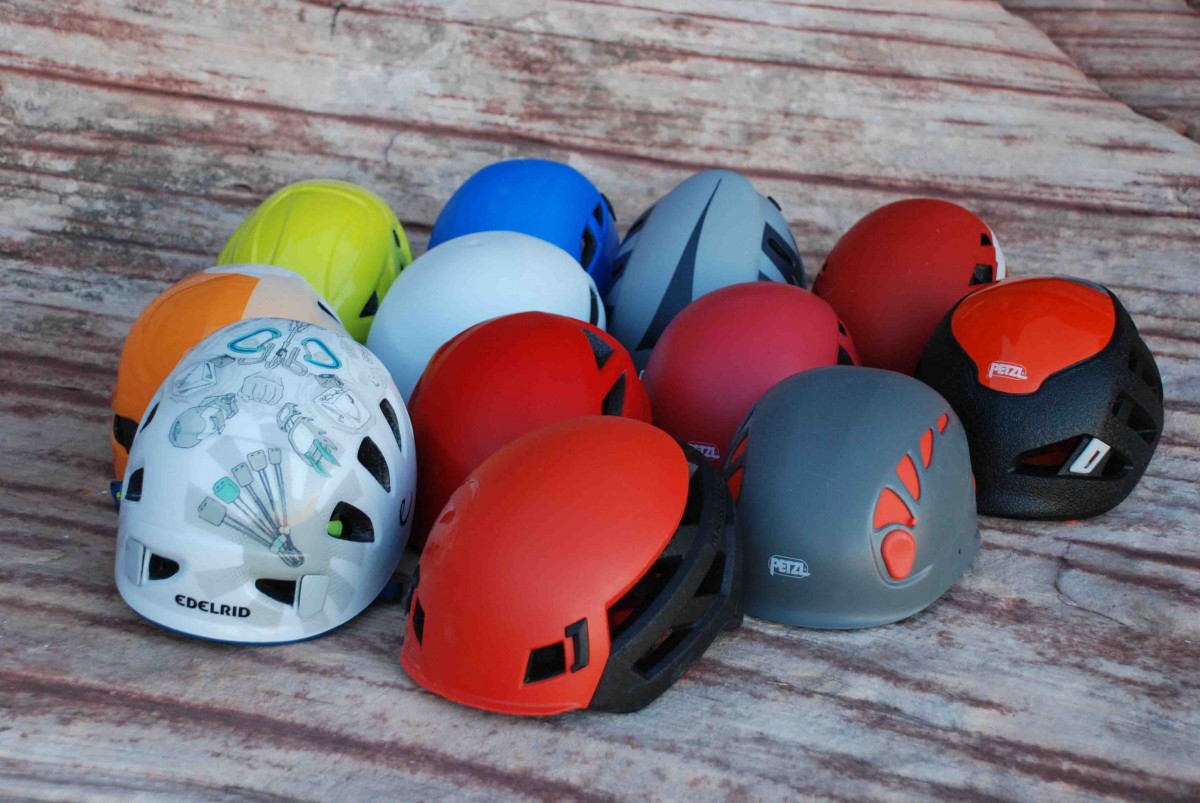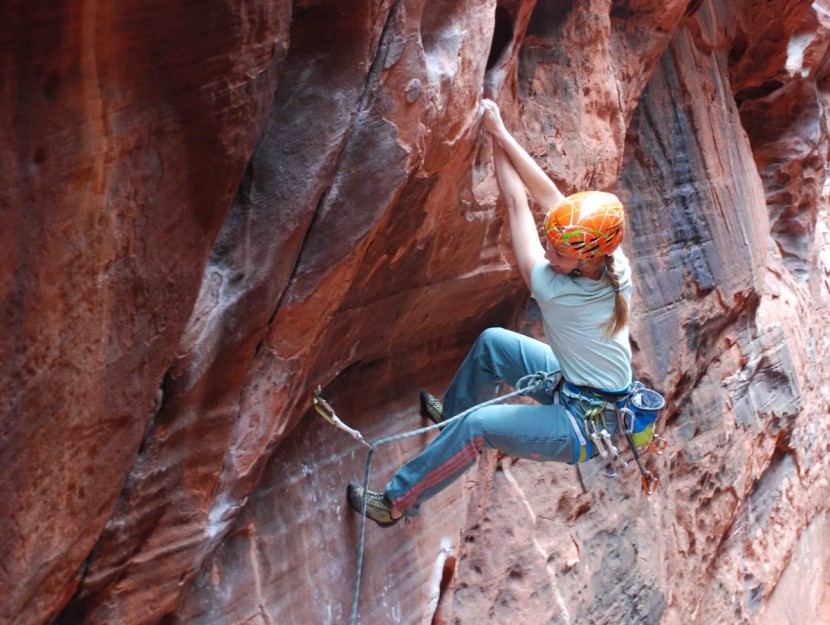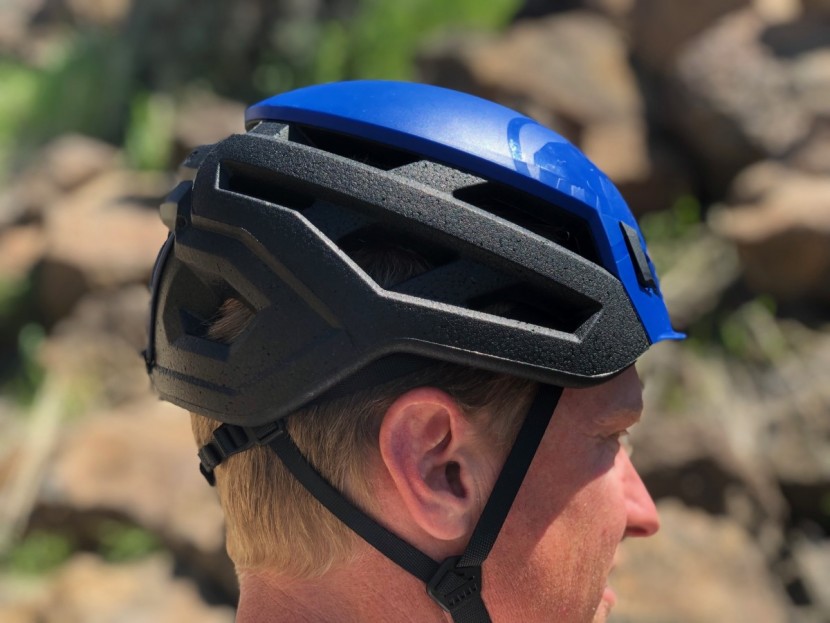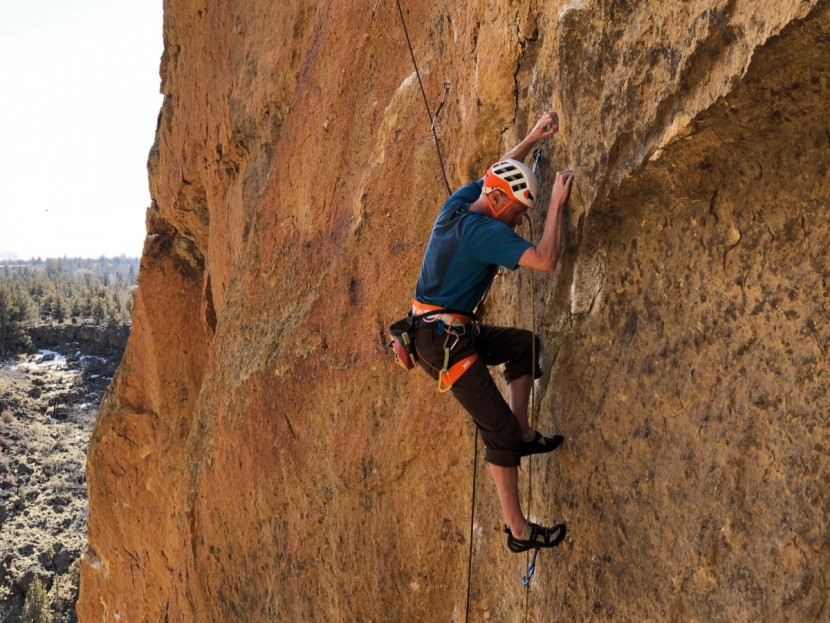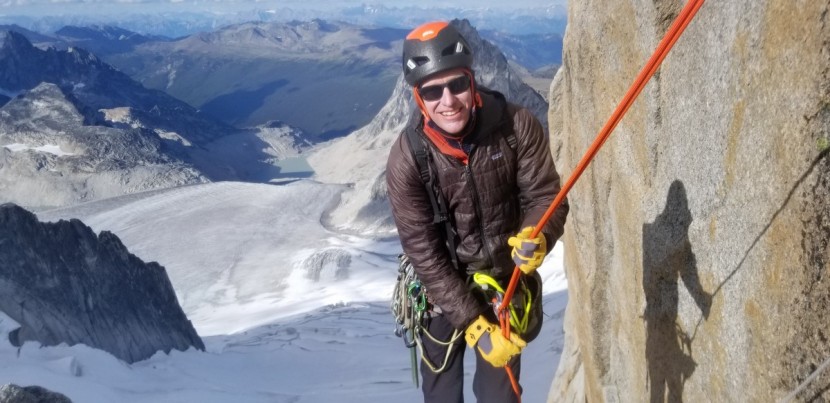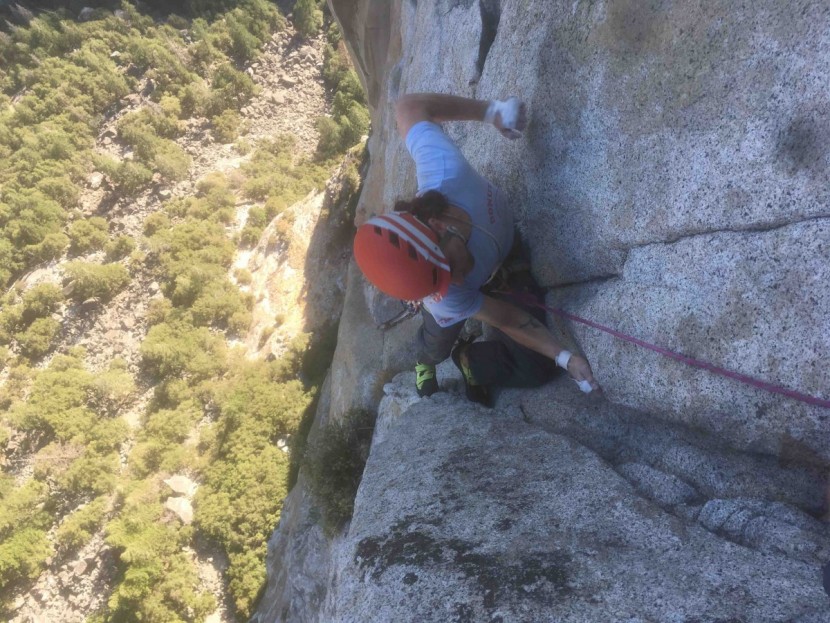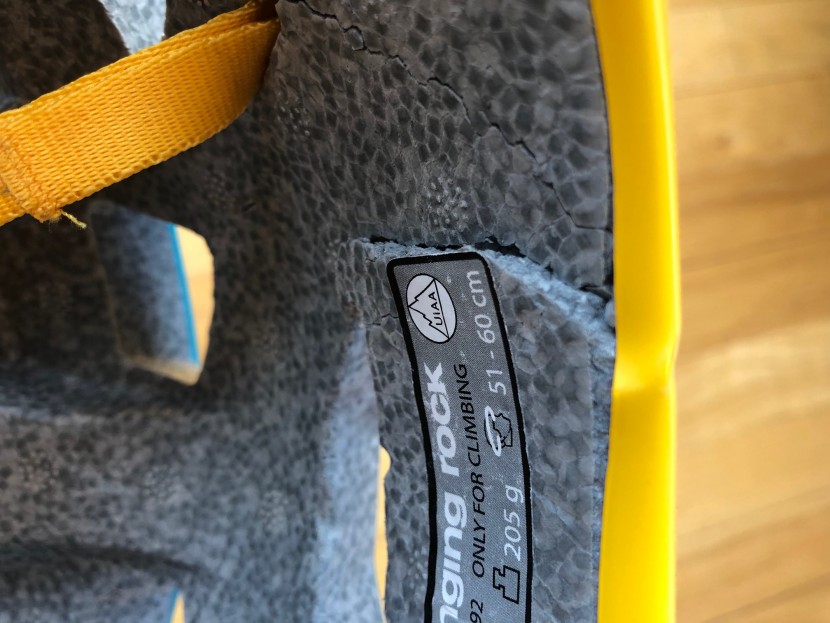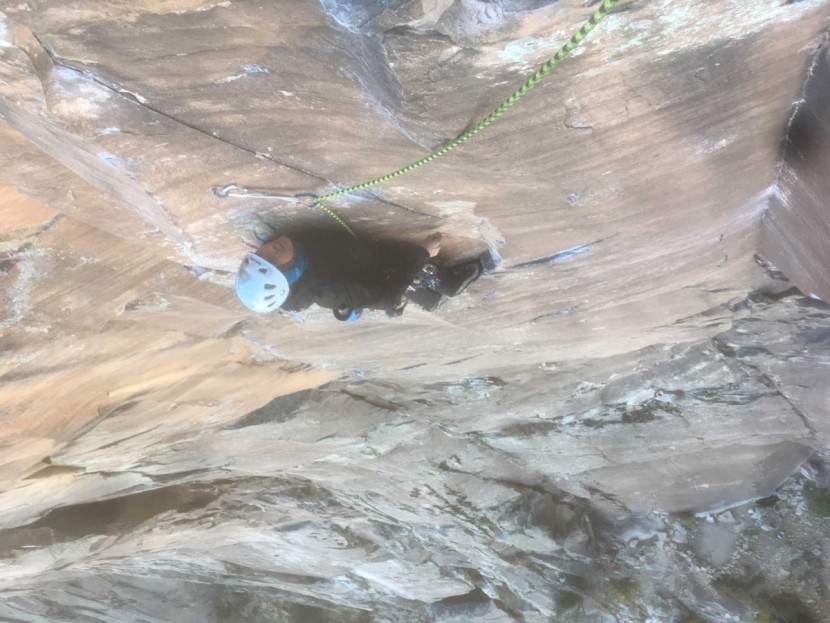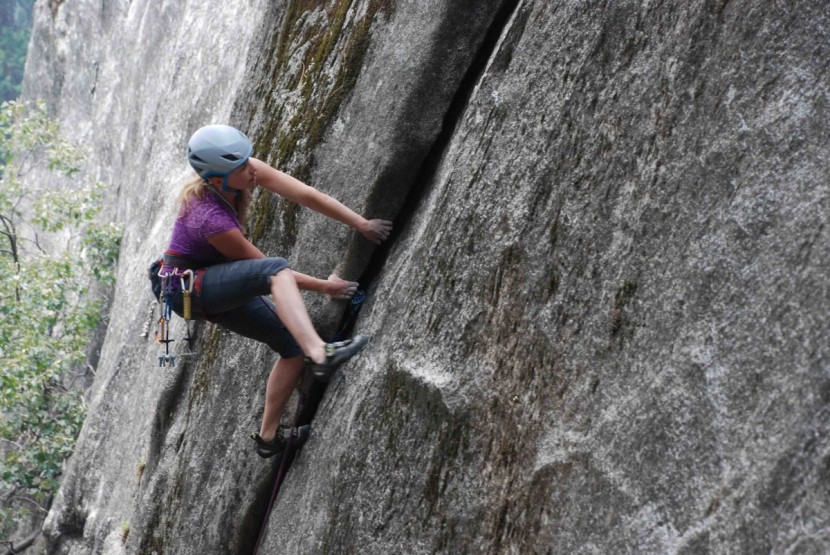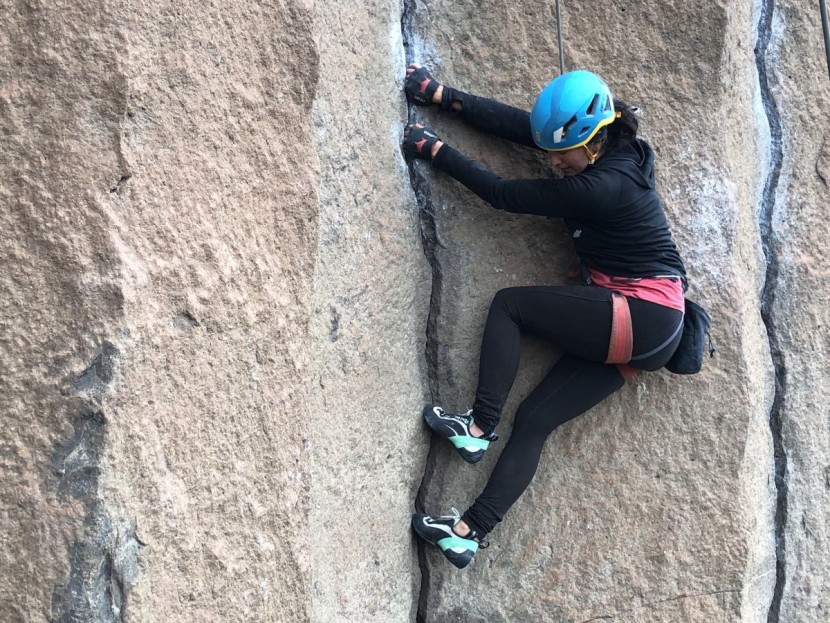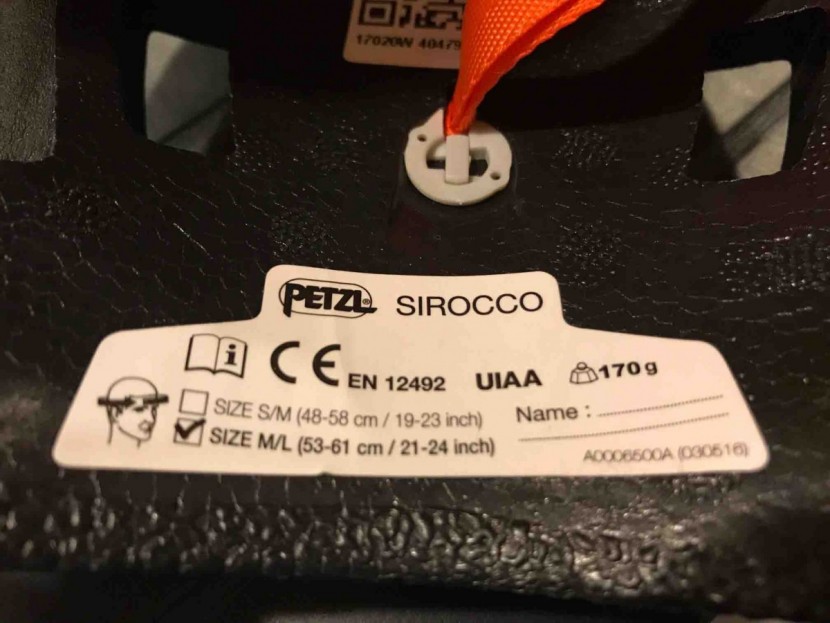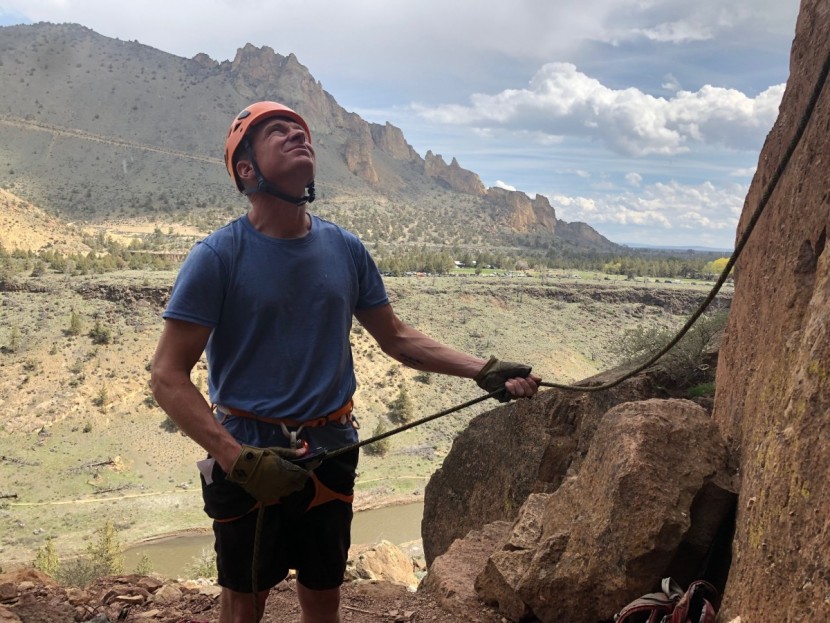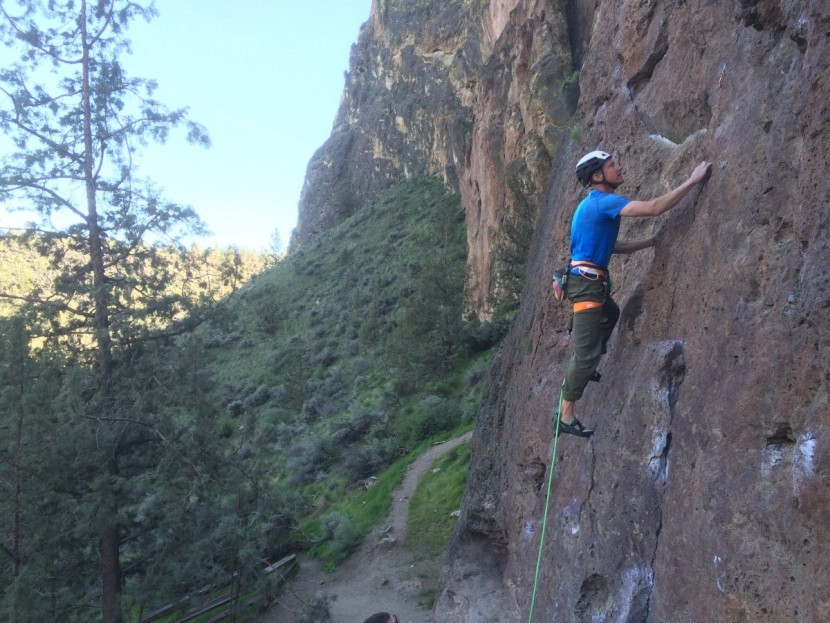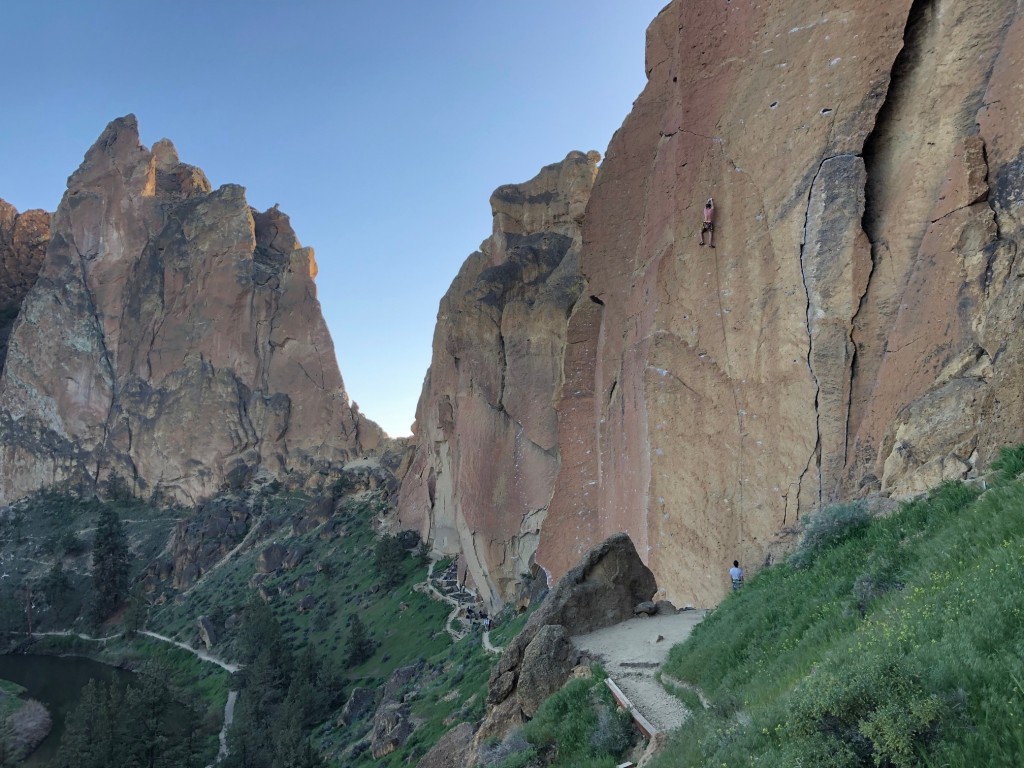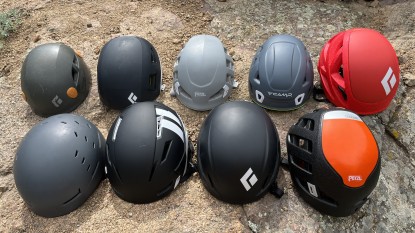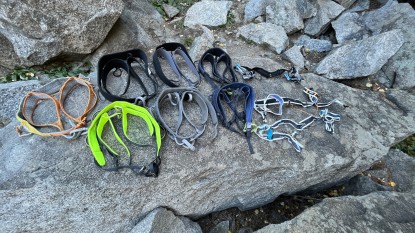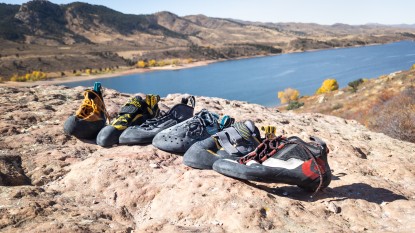There are a ton of choices when it comes to climbing helmets, and with new foam technologies, combined with technologies that have been perfected in biking or skiing helmets also making their way into climbing-specific models, this is one of the fastest-changing niches of climbing gear. While these helmets used to be a rather straightforward affair, made of a heavy, hard plastic shell and a rather elaborate internal harness, these helmets seem antiquated by today's standards. Now there are super lightweight EPP helmets, moderately lightweight EPS options, and the still classic ABS style hardshell, which have also become lighter and more comfortable over time. But what do all these acronyms mean, and how should they affect my purchasing decision? This buying advice article aims to answer these questions and more. Read on below to get the more in-depth lowdown on types of foam, adjustment systems, testing certifications, and the best options for your adventures.
Do I Need a Climbing Helmet?
Yes. How's that for a short answer? Honestly, though, the answer is a bit more nuanced. There is virtually no justification for not wearing one, although countless climbers often don't. Watch any video on YouTube (or the silver screen!) of Alex Honnold, Tommy Caldwell, or Adam Ondra, and it's a sure bet they won't be wearing a helmet, even when on the side of El Cap, where things fall all the time! Traditionally, helmets have been designed to protect you from things falling from above, and if this is likely, then there is no good reason not to be wearing one. Think alpine climbing, multi-pitch routes, anywhere where there is loose rock, when you are climbing below others, ice climbing, or just hanging out at the base of a crag.
Recently, however, with the introduction and now widespread use of EPP foam (explained below) in the construction of these helmets, many are also designed to protect your head from side impacts, like what you may sustain if you hit your head against the rock while falling. This is an added incentive to wear helmets and one that is even stronger with the addition of Mips anti-concussion technology to climbing helmets as well. Basically, any time you fall, you are in danger of hitting your head, and a high-quality helmet can only help you.
There is one notable exception to the rule: steep, overhanging sport climbs. If you fall on a steep bolted climb, you land in space as the rope catches you, with virtually no chance of hitting the rock with your head. Incidentally, this also happens to be the type of climbing that most movies are made of, and where the pros don't wear helmets. If you are a beginner, it's an excellent idea to buy a high-quality helmet and get used to wearing it anytime you are climbing, even at the bottom of the cliff. If you are an experienced climber, the newest technology has made it such that there is no reason not to be wearing one unless you are climbing steep bolted routes.
Lightweight Foam: EPP vs. EPS
Every climbing helmet that you buy today uses a version of lightweight foam to serve as the impact diffusing agent. This is true regardless of whether the foam shows on the outside or is fully encased in a hard plastic shell (more on those below). When foam takes an impact from a falling object or from hitting the rock after falling, it deforms, squishing inward as it absorbs the impact forces, sometimes even cracking. In most cases, the foam in your helmet is only capable of sustaining one large direct hit in that specific area before needing to be retired. If a second hit happened to an area that had already sustained damage, the resulting squished foam would not absorb nearly the amount of force, likely rendering the helmet useless. Hard plastic can help absorb and deflect some light blows, helping the foam inside the helmet “live” longer. There are two main types of foam used in climbing helmets, each with their advantages and disadvantages:
EPS — Expanded Polystyrene
EPS is the most common type of foam found in climbing-specific helmets. EPS is the same stuff that packaging peanuts and Styrofoam coolers are made of, although the stuff in your helmet is of a much higher grade. The density of EPS is “tunable” for absorbing harder or softer impacts. EPS can only absorb one hard impact before it needs to be retired; while it may rebound in shape slightly over time, the energy transmitting properties of the foam expire during one impact event. Most often, it will crack and break when it takes a direct hit, so there will be no debate in your mind about whether the helmet is still usable or not. In these helmets, EPS is usually covered in some form of plastic shell to protect it from “softer” impacts, which may ruin its ability to absorb the significant “hard” impact against which it would otherwise protect. Although this article talks more about EPS regarding biking helmets, we still found it very informative for understanding what is happening when your EPS helmet takes a blow.
Pros and Cons of EPS FoamExamples: Black Diamond Vapor, Black Diamond Vector, Petzl Meteor, Camp USA Storm, Singing Rock Penta, Black Diamond Half Dome, Mammut Skywalker 2
EPP — Expanded Polypropelene
Expanded Polypropylene (EPP) is a very similar material to EPS, except that its manufacturing process is proprietary. In stark contrast to EPS, it is softer and more rubbery, and not instantly crushable, meaning it can absorb more and softer blows without needing to be retired. Worth mentioning is that a very hard impact will still likely permanently damage it, so consider retiring an EPP helmet after a hard blow. EPP is most often used on the sides of a helmet to provide more protection against hitting your head on the wall when falling and is less often used on the top of the head to absorb impacts from rocks.
Pros and Cons of EPP FoamExamples: Mammut Wall Rider, Mammut Wall Rider Mips, Edelrid Salathe
Combinations
Some products use a combination of EPP and EPS foam. These generally have a plate of hard EPS on the top to protect from a potentially hard impact from falling objects. They then use EPP around the sides and back of the head to give more resilient and multiple impact protection from falling and hitting your head.
Examples: Petzl Sirocco, Petzl Boreo
Hardshell Helmets
Hardshell helmets are what they sound like — a hard plastic shell helmet. In the cases of old school helmets, such as the Petzl Ecrin Roc or the original Black Diamond Half Dome, there was no foam incorporated into these designs, and the hard shell itself provided all of the protection. These days, hardshells use foam as part of their impact diffusing designs, which muddies the waters a bit when discussing what a hardshell is versus a lightweight foam helmet. Not only do all hardshells incorporate foam, but every foam helmet we tested also has some form of hard plastic covering it! The old definitions are breaking down. However, one way to think of these helmets is that with hardshells, the plastic shell is part of the impact-resisting design, whereas most lightweight foam helmets use a shell of some nature but mostly to merely protect the foam. Therefore, hardshell helmets have a much thicker piece of plastic on the outside, and this plastic generally covers the entire helmet.
Pros and Cons of Hardshell HelmetsExamples: Black Diamond Half Dome, Petzl Boreo, Mammut Skywalker 2
Regardless of whether a helmet is termed a “hardshell” or not, it has on the outside one of two different types of plastic: ABS or Polycarbonate.
ABS
ABS (Acrylonitrile butadiene styrene) is a blended thermoplastic that used to be what composed all hardshell helmets. However, Polycarbonate has largely replaced ABS as the plastic of choice for climbing helmets, and among the choices in our review, only the Petzl Boreo still uses ABS plastic. Compared to Polycarbonate, the advantages are lower price and lower weight.
Polycarbonate
Most helmets now use polycarbonate for their plastic shells, regardless of whether they are a “hardshell” design or a lightweight foam one. Polycarbonate is stronger, more flexible, and more durable than ABS, so it can be used in thinner sheets to coat the outsides of brittle, single impact-absorbing EPS foam to add longevity and durability, sort of like an eggshell. This design is very popular among those we have tested, although the hardness of the Polycarbonate shell varies greatly between manufacturers and models. The shell on the BD Vector and BD Vapor is fragile, so much so that it seems to do very little to protect the foam beneath, and easily dents.
On the other hand, the shells covering the Petzl Meteor and Camp USA Storm are strong enough to resist denting when getting thrown around. The small top shield on the Petzl Sirocco is very hard to protect the plate of EPS beneath it, while the EPP foam around the sides of the helmet is left un-shielded. While it is a classic “hardshell” that used to be ABS, the Black Diamond Half Dome is now made of a thicker piece of Polycarbonate instead.
Inspecting and Retiring Your Helmet
Every model we have reviewed here, and indeed, virtually every product available these days uses one of either EPS or EPP foams or a combination of both. Even if you have a hard ABS plastic shell helmet, there is EPS foam on the inside beneath it, providing the bulk of the impact resistance. EPS foam, in particular, deforms or cracks when it takes an impact. It is this deformation that provides the “shock absorption,” otherwise described as the forced deceleration of the object that lands on your head, thereby protecting you. However, EPS foam can only take one such blow in any given spot, and deformed or damaged foam has no ability to protect you from additional impacts. Even EPP foam, which is marketed as being able to rebound after a blow and protect against multiple impacts, still has its limits in this regard.
You should carefully inspect your helmet before each use. Your helmet being free of any dents, cracks, or deformations, regardless of what kind of foam it is made of, is critical to its performance in protecting you. Unfortunately, climbing helmets only offer one-time usage if that usage involves taking a severe blow to the head.
Manufacturers recommend you retire your helmet and purchase a new one if you discover any of the following in your inspection:
- Large dents (small dings are ok)
- Cracks
- Significant deformation
- After any blow to the head that could have been catastrophic if you weren't wearing a helmet
- Webbing systems that are frayed or torn
- Buckles that are broken or damaged
- Your helmet is fine but is 10 years old
These are general rules. We strongly recommend following the manufacturer's inspection recommendations of the specific model you choose to buy and wear.
Sizing and Protection
The majority of the helmets that we tested come in two sizes, covering a range of head sizes. This measurement is the circumference of your skull and is usually expressed in centimeters.
To find your size, use a flexible tape measure or a piece of cord, and measure the circumference of your head just above the eyebrow. Make sure to keep the measuring device level. Compare this measurement to the manufacturer's size chart to pick the right size. Consider you may want to wear a Buff or a beanie on cold days, so if you are on the cusp, size up.
You want the material to cover a significant portion of your forehead and also as much of your occipital bone in the back as possible. While getting hit from above by rockfall is one way your helmet protects you, it also offers coverage for your forehead if you fall and slam into the wall, and for the back of your head should you get flipped upside down when falling, which can happen if the rope is behind your leg. It can be the lightest or most comfortable model out there, but if it doesn't cover your skull properly, then it's not much good to you. Since every model is different, and every skull has its unique shape, what works for you might not cover someone else's head.
Women's Specific Models
Unlike the shape of a woman's hips or feet, when it comes to the difference between men's and women's skulls, the only general difference is that women tend to have a smaller circumference. There is technically no need for a female-specific model beyond two things: hair and color choices. As such, many manufacturers make a “women's” version of some of their helmets, but it's just the same as the men's in some prettier colors. This scenario is the case with the women's Black Diamond Vector and Half Dome models.
While not all women have long hair and wear ponytails, those that do (and the guys too!) know that it can be challenging to get a good fit in a helmet. Petzl makes a women's version of the Boreo called the Borea, which is the same except for a cutout notch in the rear adjustable harness where a ponytail can comfortably sit.
Some of the unisex models that we tested can also be ponytail compatible. If the tightening band sits high enough on your head, there may be room below it for a ponytail. Alternately, if there is enough room between the tightening band and the helmet itself, you can always slide it through the gap. This arrangement worked best with the Petzl Sirocco and Mammut Wall Rider, but not at all with any of the models that used a click-wheel to tighten it.
Kids Specific Models
If you're taking the little ones out climbing, it's always a good idea to put them in a helmet as well. There's nothing specific that children need out of a helmet — other than to wear it all the time! They'll typically need a smaller size than the average adult and something that they can grow into. Because children's heads grow so rapidly, they might outgrow it quickly. While the smallest version of some helmets may work great for the kids, there are also some kid-specific designs available these days.
Certifying Agencies
All of the climbing helmets that we tested display the CE label, which means that they meet the CE EN 12492 requirement. This certification is a standard for mountaineering helmets established by the Conformité Européenne; if a manufacturer wants to sell their products in Europe, it has to pass their test. Also, many products meet the voluntary UIAA standard, which is a little more stringent. Here's what you need to know about these tests.
First, a 5 kg mass is dropped from a height of 2 m while the helmet is on a head form. There's a sensor in the neck of the head form that can't register more than 10 kN for the CE test and 8 kN for the UIAA standard. Then there's a frontal, lateral and dorsal test, where a 5 kg mass drops again but this time from a height of .5 m while the helmet tilts at a 60-degree angle. Still, the neck form can't register more than 10 kN for the CE test and 8 kN for the UIAA. The standard for the penetration test is the same for both bodies — a 3 kg mass with a sharp tip drops from a height of 1 m. The tip can penetrate the helmet but can't touch the head form. There's also a slippage test and a strength of chin strap test.
All of Petzl's models are certified to both the CE and UIAA standard, while other manufacturers, like Mammut, only do the CE. In Black Diamond's lineup, the Vector and Half Dome are CE and UIAA, but the Vapor is only CE.
Skiing in a Climbing Helmet
Climbing helmets have become increasingly popular for use while ski mountaineering. Skimo and randonee races require a helmet, and a lightweight climbing helmet is a preferred choice. This practice makes sense for many reasons. First, these helmets are super light. They also have fantastic ventilation, making them far more comfortable to wear while climbing a mountain than a ski helmet, which tend to have no ventilation and be hot and heavy. They also protect from falling obstacles frequently encountered on the side of a mountain in the winter. Petzl has worked to create the first CE certification for ski touring helmets, combining the requirements for mountaineering helmets with side and back impact protection. Both the Meteor and Sirocco meet this standard, and we found that the Mammut Wall Rider and Wall Rider Mips are also designed with ski touring in mind, although they do not currently possess this CE certification.
However, climbing helmets are not rated to the same protection standards as downhill ski helmets, and shouldn't serve in place of one.
Choosing the Right Product
Selecting the best climbing helmet for you will depend on your own needs and experience, as well as your budget. While we have laid out our best recommendations in our climbing helmets review, individual needs will dictate the best choice. To help you with your decision-making process, we recommend asking yourself the questions below, which should help you narrow down the selection a bit.
What is My Experience Level?
Beginner climbers and those who climb infrequently, or those who only climb close to the ground and virtually never climb multi-pitch, can get away with buying a hardshell ABS style helmet. These helmets are generally the most affordable, so they can save infrequent or beginner climbers some money. Experienced climbers, those who climb often, or who climb multi-pitch routes or alpine climb, should focus on buying a lighter weight helmet, as this will greatly improve their experience and make them far more likely to wear their helmet. Lighter weight generally rules out hard shell, ABS-style designs. We think all climbers will like lighter helmets better, but some may not want to pay the premium for them.
What is My Budget?
These products range widely in price, with the most expensive costing nearly four times the least expensive price. Identifying your budget can help you target the best choice for you. Only infrequent climbers should consider buying the most affordable models, as these come with downsides, such as weight, bulk, and lack of comfort, that frequent climbers will not be content with, regardless of the tightness of their budget. The Petzl Meteor offers the best performance/price combo for one who doesn't want a heavy helmet but wants to save as much money as they can. Since a helmet is something you will wear every time you climb, and since both comfort and performance generally increase drastically by buying a higher-priced helmet, we encourage any climbers who can to avoid valuing budget as the primary consideration.
Do I Want Mips Protection?
Mips (Multi-directional Impact Protection System) BPS (Brain Protection System) protection has been shown in scientific studies to help absorb certain impact forces, which could potentially reduce concussions or brain injuries. So, the answer to this question, for literally everyone, should be YES. However, currently, there are only a few models that we have tested that offer this system, and they are among the most expensive models you can buy. We expect to see more Mips climbing helmets on the market in the future.
What is the Shape of My Head?
If you have made it this far, you have decided that you want a lightweight and comfortable helmet, which rules out the ABS shell designs. You may or may not have a budget in mind, but for some reason (money, fit), you are not going with the Wall Rider Mips. The final consideration is the shape of your head. Lightweight helmets are made of molded foam and generally have a pretty minimalist harness and adjustment system to keep them light. Therefore, for optimal comfort, you need to start with a mold shaped somewhat like your head. If you have a narrow, oblong head, then a shallow, round helmet will not provide the most comfortable fit, even after adjustment. Read our individual reviews to find out how each helmet fits and its general shape, and consult a friend or loved one about the shape of your head, if you need to.
Conclusion
All climbing helmets will add to your margin of safety on the rocks, ice, and in the mountains. Which one you choose to buy depends on your level of experience and budget. While the lowest priced models are a good way to get into the game without spending extra money, we find them to be sufficient only for beginners and climbing close to the ground. Anyone looking to buy their second helmet or who intends to climb multi-pitch routes or alpine climb should be investing the extra $40 or so for a lightweight foam helmet. Our testing and opinions both concur that performance and pleasure drastically increase as weight decreases when it comes to helmets, but this also corresponds to an increase in price. When purchasing a helmet, you do get what you pay for, but considering that a helmet is usually a long term purchase, we think it is a great idea to think with your brain, rather than your wallet, and purchase the best climbing helmet that fits comfortably on your head.

